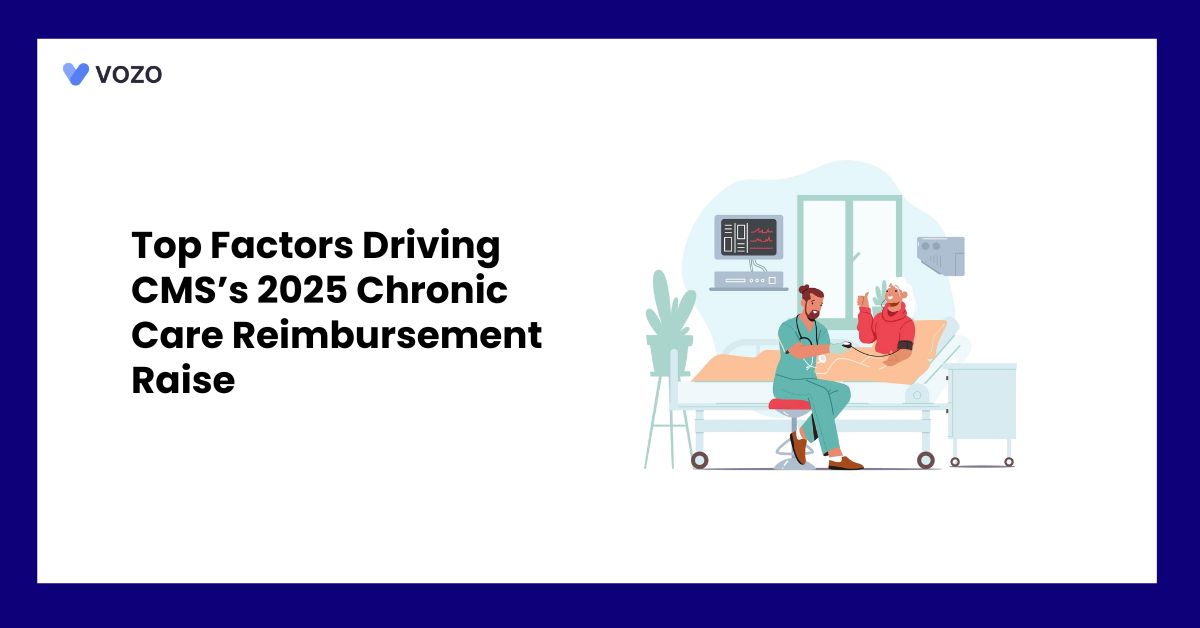Top Factors Driving CMS’s 2025 Chronic Care Reimbursement Raise
CMS has always been an important player in US healthcare policy. CMS frequently provides innovative approaches to enhance care delivery and control costs by optimizing provider compensation and improving patient outcomes.
By 2025, CMS plans to raise payment for chronic care management services significantly, adding more funding to assist the care of patients with long-term illness. In this blog, you’ll learn the reasons behind the 2025 CCM reimbursement rise and how this decision fits into overall healthcare trends.
Understanding Chronic Care Management
Chronic Care Management refers to various services that are designed to help patients with two or more chronic diseases. Patients with chronic illness receive coordinated care through traditional hospital visits.
These disorders can long for at least a year and put the patient at risk of worsening health or functional loss. Diabetes, hypertension, asthma, heart disease, and depression are all usual occurrences.
- Creating and maintaining a thorough care plan.
- Through regular phone check-ins, patients are monitored.
- Coordinating treatment across many providers: experts, home health, labs.
- Using approved electronic health records to track and communicate data.
CMS first launched CCM in 2015, but adoption remained low owing to complicated billing regulations, poor provider understanding, and low reimbursement rates. That is changing with the 2025 upgrades.
Key Reasons CMS Is Boosting Chronic Care Reimbursements in 2025
1. Rising Burden of Chronic Diseases
Over 90% of Medicare spending is related to chronic diseases, which are the primary causes of death and disability in the US. CMS is dealing with growing long-term care expenses as a result of an aging population.
Rather than waiting for people to end up in the ER or hospital owing to mismanaged chronic conditions, CMS is focusing on prevention. CCM promotes patient wellness by encouraging physicians to:
- Monitor progress proactively.
- Adjust drugs regularly.
- Intervene before the problem escalates.
2. Moving Towards Value-Based Care
CMS has long pushed providers to adopt value-based care models, in which success is evaluated by patient outcomes rather than the number of visits or procedures. CCM provides a practical access point into this system because:
- It rewards care continuity.
- It enhances outcomes with continuing support.
- It allows data tracking to measure real-world outcomes.
Providers who practice good chronic management, such as monitoring blood sugar levels in diabetic patients, managing hypertension, and coordinating treatment, will improve outcomes.
3. Integrating Telehealth and Remote Monitoring
Healthcare is evolving towards AI-powered decision support, RPM, and digital therapies. CMS’s modification to CCM codes indicates its acknowledgment that chronic care will grow.
- Telehealth has emerged as a key tool for addressing chronic diseases, particularly during the COVID-19 pandemic.
- RPM devices, virtual consultations, and patient portals are all important tools for managing chronic diseases, especially for people who may not have access to in-person appointments.
Increasing reimbursement rates for CCM services encourages healthcare providers to use telehealth and remote monitoring systems, which can enhance patient access to care, minimize administrative burden, and raise patient satisfaction.
Related: How Population Health Management Aligns with CMS and Value-Based Care Initiatives
4. Support for Rural and Underserved Communities
Rural practices, Federally Qualified Health Centers, and underprivileged urban clinics frequently bear the greatest burden of chronic disease. However, these suppliers have generally lacked the administrative support and infrastructure to launch CCM initiatives.
- CMS helps by increasing reimbursements and simplifying compliance.
- Rural clinics employ or outsource care coordinators
- Small practices utilize telehealth and EHR-integrated solutions.
- Safety net providers engage in digital workflows.
5. Assistance for Healthcare Providers
- Healthcare practitioners, particularly primary care physicians, are under growing strain as patients’ needs become increasingly complex.
- Managing patients with various chronic conditions may be time-consuming and often requires more than just in-person visits.
- The financial pressure may be worsened if doctors are not adequately rewarded for their time and resources spent on these patients.
What Does This Mean for Providers?
1. Revenue Streams for Providers
Providers who use telehealth or remote monitoring systems in their clinics may be able to receive better payments for managing chronic patients.
A cash boost could also help to expand care teams, which include nurses, care coordinators, and medical assistants, all of whom play important roles in chronic disease management.
2. Increased Incentive to Focus on Prevention
With increased compensation for chronic care management, physicians may shift their focus from reactive treatment to proactive, preventative care.
This improvement could lead to earlier therapies for people with chronic diseases, resulting in better long-term health outcomes and cheaper healthcare costs.
3. Adoption of Technology Solutions
To satisfy the demands of chronic care management, physicians will most certainly need to implement new technology, including EHR, telehealth platforms, and RPM.
Although the initial investment in this technology can be significant, higher reimbursement rates will most certainly outweigh the expenses and allow providers to improve care delivery.
What Does This Mean for the Patients?
1. More Personalized and Continuous Care
Patients will have more regular interactions with their care teams, not just during clinic visits, but also between appointments. Care coordinators may conduct monthly check-ins, update care plans, and verify that medication and treatment regimens are on track.
2. 24/7 Access to Care Teams
CCM programs usually provide 24-hour access to care coordination teams, allowing patients to contact them with questions or concerns at any time, including nights and weekends.
3. Improved Medication Management
Care teams utilize CCM to verify that patients are taking their medications appropriately and that any side effects or concerns are addressed as soon as feasible. This leads to increased adherence and fewer difficulties.
Related: Why CCM and RPM Matter for Pre-Dialysis of CKD Patients
Vozo’s Remote Patient Monitoring Solution
Remote patient monitoring brings healthcare checkups to your fingertips. With the support of RPM devices, healthcare practices become straightforward and convenient for both patients and providers.
Vozo RPM solution is the best option to adapt for healthcare professionals. Our remote patient monitoring solution will help to track and evaluate patient vital signs and health data.
It is advantageous to communicate with patients digitally to adjust treatment plans and educate them about their health conditions. Our RPM program will allow you to improve patient health outcomes and reduce readmissions.
Leverage Vozo’s Remote Patient Monitoring Program to provide healthcare conveniently.
About the author

With more than 4 years of experience in the dynamic healthcare technology landscape, Sid specializes in crafting compelling content on topics including EHR/EMR, patient portals, healthcare automation, remote patient monitoring, and health information exchange. His expertise lies in translating cutting-edge innovations and intricate topics into engaging narratives that resonate with diverse audiences.













